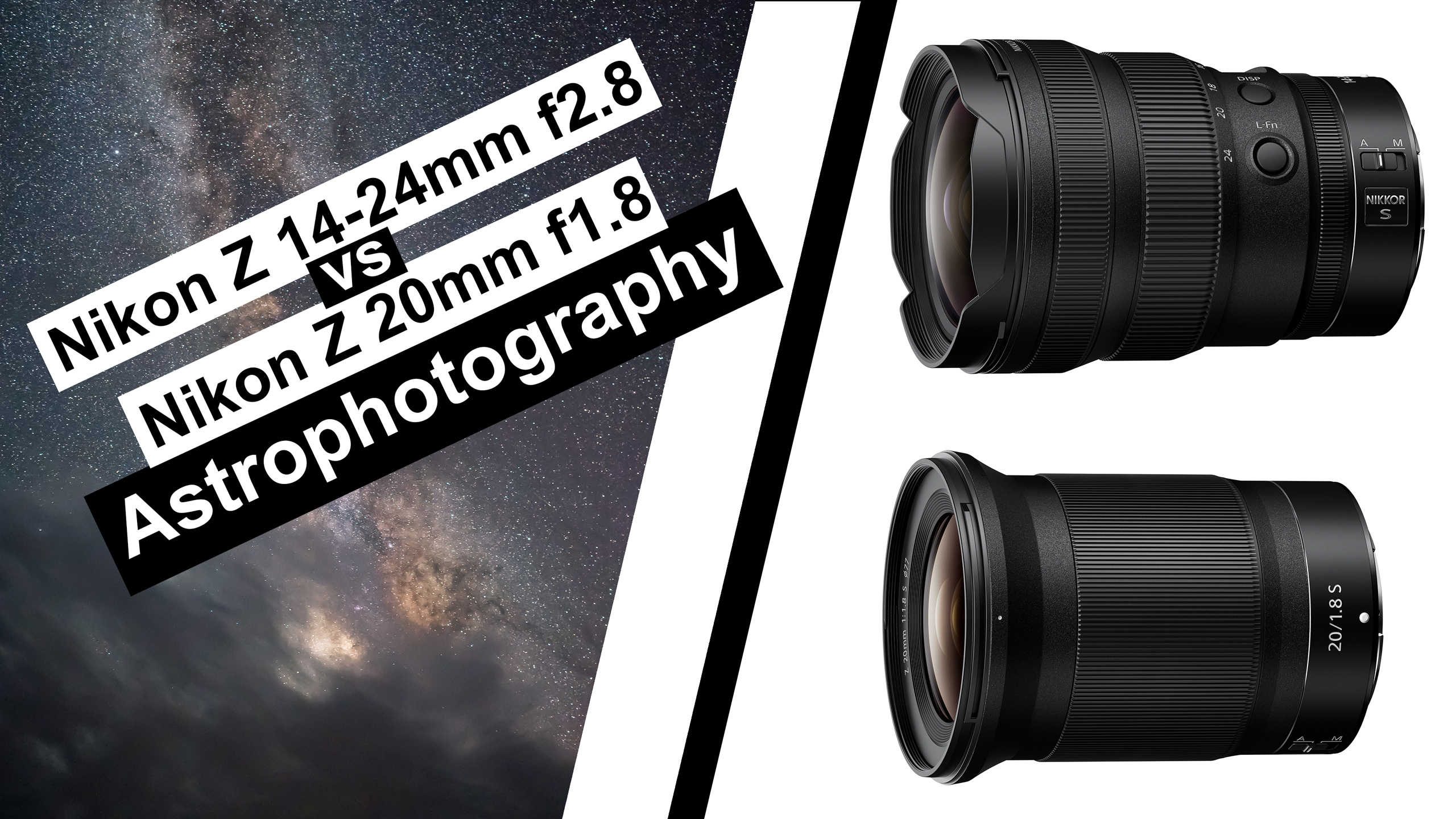Nikon Z 14-24mm f/2.8 S vs Nikon 20mm f/1.8 S Astrophotography Comparison
This article may contain affiliate links.
I’ve been trying to find the right lens for well over a year now to suite my astrophotography needs. I’ve compiled a list of specifications on the Nikon Z 14-24mm f/2.8 S and the Nikon 20mm f/1.8 S lens as well as my thoughts on how each lens performs with respect to astrophotography.
Just as the Nikon Z 14-24mm f/2.8 S is a great lens, so is the Nikon Z 20mm f/1.8 S. There are two key differences when evaluating their use for Astrophotograhpy. The first one is the adjustable focal length of the 14-24mm lens. The second is the maximum aperture of f/1.8 for the 20mm lens. The 20mm lens is going to bring in more light at a 20mm focal length than the Nikon Z 14-24mm will. However, the 14-24mm will allow the user a range of focal lengths to choose from. I find that can be handy when in the field and trying to find the right composition.
Key Specifications of the Nikon Z 14-24mm f/2.8 S Lens:
- Focal Length: 14-24mm
- Maximum Aperture: f/2.8
- Minimum Focus Distance: 11”
- Optical Design: 16 Elements in 11 Groups
- Diaphragm Blades: 9, Rounded
- Format: Full-Frame
- Weight: 1.4 lbs
- Dimensions: 3.5” Diameter, 4.9” Length
- Filter Thread: 112mm
- MSRP: $2,396
Click to see the Nikon Z 14-24mm f/2.8 on Amazon.
Key Specifications of the Nikon Z 20mm f/1.8 S Lens:
- Focal Length: 20mm
- Maximum Aperture: f/1.8
- Minimum Focus Distance: 7.92”
- Optical Design: 14 Elements in 11 Groups
- Diaphragm Blades: 9, Rounded
- Format: Full-Frame
- Weight: 1.11 lbs
- Dimensions: 3.33” Diameter, 4.27” Length
- Filter Thread: 77mm
- MSRP: $1,047
Click to see the Nikon Z 20mm f/1.8 on Amazon.
Nikon Z 14-24mm f/2.8 S:
Let me start by saying that the Nikon Z 14-24mm f/2.8 is a fantastic lens. I was able to test it out recently and one of the key areas I evaluated it for was astrophotography and nightscapes. If you’d like to see my full astrophotography analysis of this lens, please take a look at my post reviewing the Nikon Z 14-24mm f/2.8 S for Astrophotography and nightscapes.
I had a few key take-a-ways when I was out in the field using this lens. First off, the optics on the Nikon Z 14-24mm are incredible. In most of my photos I noticed very little coma in the stars at the corners. The few that did have it, I’m not entirely convinced it wasn’t just that the focus was a bit off. I believe that because the coma did not appear constant throughout my photos. That leads me into my next point. The biggest thing I don’t like about this lens is the digital focus system. I found that for Astrophotography it provided one more difficulty to getting pin point stars in an arena that is already hard enough to dial in the focus. Finally, I found the vignetting to be rather minimal compared to lower quality lenses I’ve shot with like the Rokinon 14mm f/2.8. I think that’s a big highlight of this lens when being used for Astrophotgraphy and nightscapes.

Comparison of vignetting across three different apertures.
Nikon Z 20mm f/1.8 S:
Looking specifically at the Nikon Z 20mm f/1.8 lens, there were a few things I liked about it for astrophotography. The first thing I liked was the ability to gather more light at f/1.8 at 20mm. This allowed me to capture some incredibly bright Milky Way photos with a 20s exposure. I was also surprised to find that I didn’t feel the 20mm focal length hindered my photos at all. If anything, it forced me to work harder to perfect my compositions. Next, I found that the vignetting was a bit stronger at f/1.8 than I would have liked. Even with that heavier vignetting though, I still found it to be a spectacular lens. Lastly, I also found the Nikon Z 20mm f/1.8 performed just as well with coma as the Nikon Z 14-24mm f/2.8 when evaluating the astrophotography images I took.

Comparison of vignetting across two different apertures.

Perspective difference between 14mm and 20mm.
Overall, I think anyone who purchases either of these lenses will be satisfied when using them for astrophotography. The optics are great with each lens, and both function incredibly well as astrophotography lenses. The biggest determining factor for me will end up coming down to my use for them and ultimately price. If I’m trying to save some money when I eventually purchase, I’ll definetly go with the Nikon 20mm f/1.8 S. If I decide to go with a lens that will give me more versatility in shooting landscapes and other genres, I’ll go with the Nikon Z 14-24mm f/2.8 S. I’ll be sure to post later on when I get to the point of purchasing and evaluate why I went with the one I decide on. Be sure to subscribe so you don’t miss that post in the future!
If you’re reading this and debating on purchasing either the Nikon Z 14-24mm f/2.8 or the Nikon Z 20mm f/1.8, I’d highly recommend renting them first from lensrentals.com. Click here to receive $25 off your first rental.
Let me know your thoughts on these two lenses in the comments below!


